Scaffold Technology Market Research, 2031
The global scaffold technology market size was valued at $1.02 billion in 2021, and is projected to reach $5.09 billion by 2031, growing at a CAGR of 18% from 2022 to 2031.Tissue engineering covers a wide range of application that repair or replaces the portion of damaged tissue. There are three components of tissue engineering such as stem cells, scaffold, and signalizing molecules. Scaffold is used for the growth and development of cells as well as provides mechanical strength to the cells.
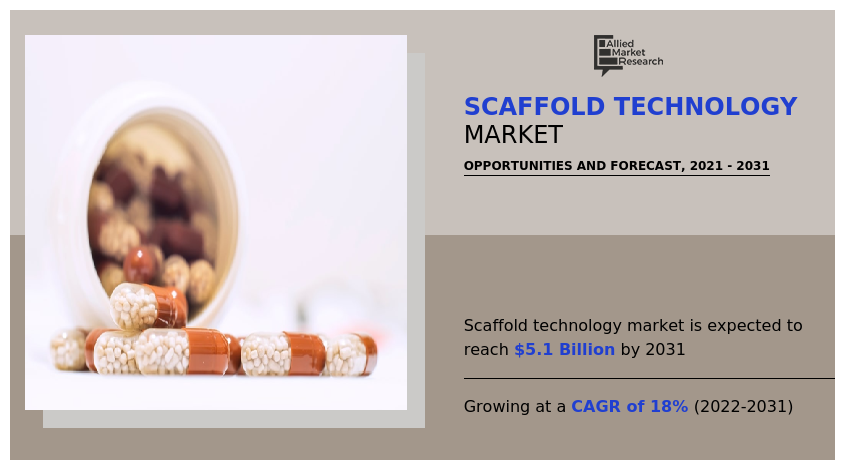
Market Dynamics
Moreover, scaffold-based platforms in 3D cell culture are used to alter the cell culture procedure by providing a surface on which the cells can easily impart 3D growth. In scaffold technology, the cells are grown within extracellular matrix or synthetic materials. Cell adhesion, proliferation, and activation depend on scaffold material properties and scaffold characteristics. To accomplish the required mechanical function and rate of new-tissue formation, different characteristics, such as materials, degradation kinetic, and scaffold properties, should be altered to match the specific application. Pore distribution, porosity, and exposed surface area of the scaffold can influence the architecture of the extracellular matrix, penetration, rate of penetration of cells, and the final effectiveness of regenerative process.
The growth of the global scaffold technology market size is majorly driven by rise in demand for body reconstruction procedures and tissue engineering, increase in usage of biomaterials, and growth of technological advancement of scaffold technology. However, high costs associated with implementation and emergence of scaffold-free technology for cell culturing are expected to hamper the growth of the market. On the contrary, increase in expenditure on R&D by governments in developing countries has high growth potential in these countries.
Segments Overview
The scaffold technology Market share is segmented into product type, type, application and end user. By product type, it is categorized into natural scaffold and synthetic scaffold. By type, it is bifurcated into macro-porous scaffolds, micro-porous scaffolds, nano-porous scaffolds, and solid scaffolds. By application, it is categorized into cancer cell research, stem cell research, drug discovery, and regenerative medicine. By end user, it is divided into biotechnology & pharmaceutical companies, contract research laboratories, and academic institutes. By region, it is analyzed across North America, Europe, Asia-Pacific, and LAMEA.
By Product Type
Depending on product type, the natural scaffold segment dominated the scaffold technology market trends in 2021, and is expected to continue this trend throughout the forecast period, owing to growing research in the field of tissue engineering and regenerative medicine to develop novel scaffolds for remodeling of biological tissues. However, the synthetic scaffold segment is expected to witness considerable growth during the forecast period due to various applications of synthetic scaffolds such as electro-spinning, 3D printing, and particulate leaching, are used to manufacture scaffolds, which differ in their material, porosities, permeability, and mechanical characteristics.
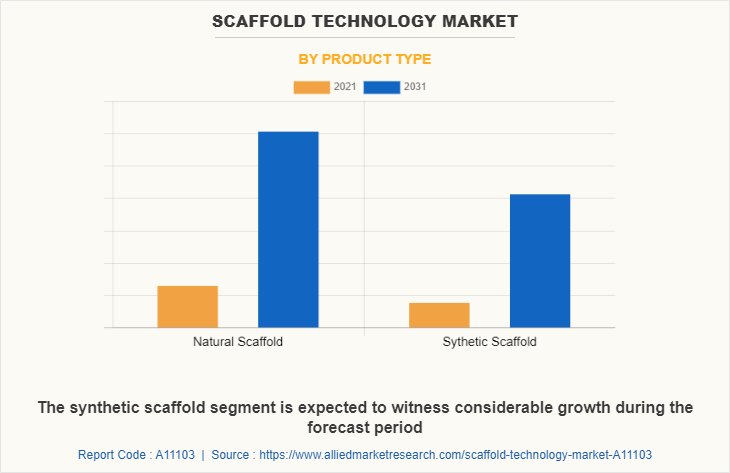
By Type
By type, the micro-porous scaffolds segment holds the largest scaffold technology market share, owing to multiple applications in areas, including 3D cell culture, gene delivery, stem cell research, tissue engineering, regenerative medicine, and wound healing. However, the solid scaffolds segment is expected to witness considerable growth during the forecast period due to wide use in orthopedic applications such as bone repair and bone tissue engineering.
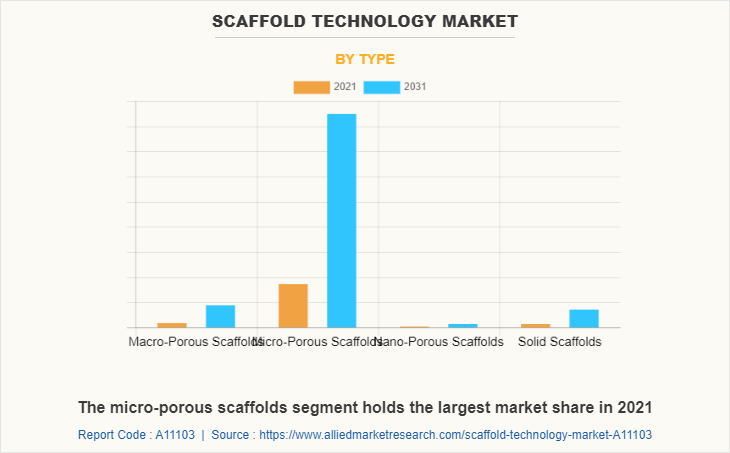
By Application
By application, thecancer research segment dominated the scaffold technology market growth in 2021, and is expected to remain dominant throughout the forecast period, owing to rise in prevalence of cancer, which has led to development of newer therapies for the prevention and treatment of cancer. However, the regenerative medicines segment is expected to witness considerable growth during the forecast period due to successful advancements in regenerative medicine therapies which are helping create less costly and more effective therapies.
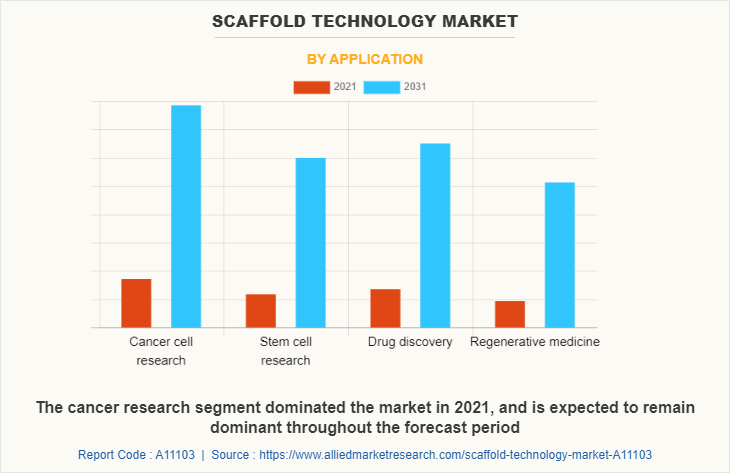
By End User
By end user, the academic institutes segment dominated the scaffold technology market analysis in 2021, and this trend is expected to continue during the forecast period, owing to extensive use of scaffold technology in tissue engineering fields such as periodontal regeneration, cartilage production, bone formation, nasal and auricular malformation repair, tendon repair, and heart valves. However, the contract research laboratories segment is expected to witness considerable growth during the forecast period due to surge in adoption of contract research laboratories services by prominent companies.

By Region
Region-wise, North America dominated the scaffold technology market forecast in 2021, and is expected to be dominant during the forecast period, owing to rise in incidences of cancer, increase in number of organ transplantation, and expansion of biotechnology & pharmaceutical companies. In addition, rise in awareness regarding the benefits of 3D cell culture, increase in funding for cell-based research, and proliferation of technological developments boost the market growth. However, Asia-Pacific is expected to register highest CAGR from 2022 to 2031, owing to rise in focus in biopharmaceutical R&D, huge production of drugs, and surge in prevalence of cancer.
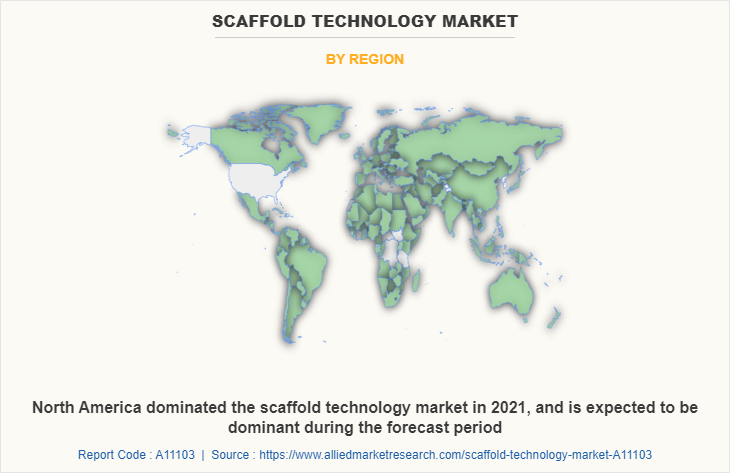
The key players that operate in the global scaffold technology market include, 3D Biotek LLC, Bico Group, Agilent Technologies, Inc. (Biotek), BioVison Incorporated, Corning Incorporated, Merck KGaA (Sigmaaldrich), PromoCell GmbH, Reprocell, Incorporation, Synthecon, Incorporated, and Thermo Fisher Scientific Inc.
Key Benefits for Stakeholders
- The study provides an in-depth analysis of the scaffold technology market opportunity and the current trends & future estimations to elucidate imminent investment pockets.
- It presents a quantitative analysis of the market from 2021 to 2031 to enable stakeholders to capitalize on the prevailing market opportunities.
- Extensive analysis of the scaffold technologymarket based on procedures and services assists to understand the trends in the industry.
- Key players and their strategies are thoroughly analyzed to understand the competitive outlook of the biodegradable scaffold industry share.
Scaffold Technology Market Report Highlights
| Aspects | Details |
| By Product Type |
|
| By Type |
|
| By Application |
|
| By End User |
|
| By Region |
|
| Key Market Players | Avantor, Inc., InSphero AG, Becton, Dickinson, and Company, Corning Incorporated, 3D Biotek, LLC, Bico Group, Synthecon Incorporated, Lonza Group Ltd., Thermo Fisher Scientific Inc., ReproCELL Incorporated |
Analyst Review
According to the insights of CXOs of leading companies, the adoption of 3D cell cultures for research purposes has increased in the recent years, due to the ability of these cultures to create and mimic in-vivo environment in-vitro. The microenvironment produced by this technique has an impact on the growth, differentiation, morphology, gene expression, and behavior of the cells.
Therefore, the scaffold technology market is expected to witness a steady growth in the future. The market has drawn the interest of the healthcare industry, owing to increase in prevalence of cancer, surge in stem cell research, and drug discovery. The market growth is propelled by surge in 3D cell culture techniques and R&D activities; hence, the market is anticipated to witness intense competition. Further, the adoption of these scaffolds has increased considerably, owing to the adoption of technological advanced biomaterials in 3D cell culture, increase in tissue engineering, and rise in demand for organ transplantation, which propel the market growth. In addition, increase in product approval is expected to boost the market growth in the near future.
Shift in preference toward 3D cell cultures for cancer research is one of the major upcoming trends in scaffold technology market
Cancer research is one of the leading applications of scaffold technology market
North America accounted for the largest market share in the viral clearance market in 2021 and is expected to retain its dominance throughout the forecast period. This is primarily attributed to increase in demand for biopharmaceutical and upsurge in demand for advanced technologies in the purification of recombinant proteins produced by animal cell cultures to create high-value products of modern biotechnology.
The global scaffold technology market was valued at $1,026.0 million in 2021, and is projected to reach $5,095.3 million by 2031, registering a CAGR of 18.0% from 2022 to 2031.
3D Biotek LLC, Bico Group and Agilent Technologies, Inc. are few major companies operating in the scaffold technology market
Asia Pacific is expected to be the fastest growing region in scaffold technology market in 2021.
Product launch was one of the major strategy adopted by key players operating in scaffold technology market
Higher implementation costs coupled with irregularity in 3D cell culture outcomes are 2 major factors restraining the market growth.
Loading Table Of Content...



